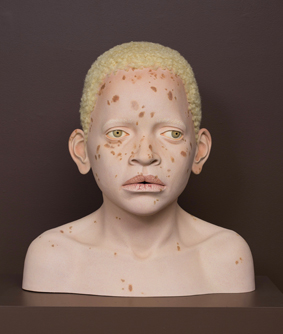
By Kaiya Gordon /// Features Editor
If you’ve been to the top floor of the Portland Art Museum lately, you’ve seen them—tremendous ceramic busts, larger-than-life (one figure, a reclining female designed to be representative of “Mother Africa” is twice-life-size, in fact), gazing at museum-goers through blue, milky eyes. The sculptures, created by Seattle artist Tip Toland, are meant to portray the troubling trend of using body parts from albino children for remedies and doctoring in Tanzania. The ceramic work itself is striking and beautiful–Toland eschews working with glaze, opting instead to apply a mixture of paint, pastel and pencil directly to the ceramic, working with the pieces as though she is applying makeup to human skin.
But Toland’s work with Tanzanian subjects puts the viewer in a disturbing position. Toland doesn’t seem to have any connection to Africa beyond what she has learned about albinism in children–knowledge which was sparked, according to the pamphlet on display at the Portland Art Museum, by a web article. Toland’s lack of connections to Africa might suggest that this piece is something other than the “startling” work with “powerful political subtext” it is being described as.
Through the pieces, Toland confronts the viewer with what she sees as a political horror–the maiming of children in Africa. While it is universally agreed upon that the practice of harvesting body parts is despicable, it is striking that Toland is being heralded for her work describing “Mother Africa” when her website and resume don’t indicate that she’s ever even been there. Toland’s sculptures, therefore, put the viewer in a tricky position. Not only are museum-goers confronted with an exhibition which intends to address “the murder or maiming of albinos for the marketing of their body parts to witch doctors for ritual use,” they also become complicit in Toland’s views of this event.
The sculptures don’t immediately reveal themselves to be about abuse; rather, the viewer must examine the pieces carefully to pick up clues—first recognizing the chapped lips,and sunburned skin, eventually noticing the amputated arms of two of the sculptures.
Toland’s attention to detail requires audience participation in the work. But what is the audience participating in? As a voyeur of Toland’s work, we are ultimately looking at an outsider’s interpretation of a complicated cultural practice. Outsider interpretation is not intrinsically problematic, but when it suggests, like Toland’s work does, that it has authority on that practice, it seems a larger conversation is needed. Further, Toland’s representation of “Mother Africa” as a woman waking to a problem assumes that Toland, as an artist, has the jurisdiction to determine what Africa should feel and how it should respond to this practice. Toland’s request of action extends, in fact, to the reader. The pamphlet states that these works are “portraits of horror that serve to inform Toland’s audience and, potentially, motivate them to take action.”
So far, reviews of the exhibit at PAM until May 4, don’t address any of the cultural or political implications of the work. But I think a few questions might arise for viewers. What authority does Toland have to “inform” viewers about a practice happening in Tanzania? How does Toland’s assumption of authority legitimize responses that are potentially culturally misinformed? And what kind of responsibility does this work shift to the viewer?
As a museum attendee who has as little experience with Africa as Tip Toland, I feel uncomfortable drawing concrete conclusions about the exhibit. But it seems dangerous to continue to herald Toland for this work without reservations. I hope that Toland’s sculptures can spark productive conversations on the LC campus.
Kaiya Gordon is the features editor of the Pioneer Log. She likes to write stories about pertinent on-campus events, conduct interviews, and talk about food. Kaiya is a contributor to the English Department’s newsletter at Lewis & Clark, and is a recent NUCL participant. Follow her @aiyakay
Subscribe to the Mossy Log Newsletter
Stay up to date with the goings-on at Lewis & Clark! Get the top stories or your favorite section delivered to your inbox whenever we release a new issue.

Leave a Reply